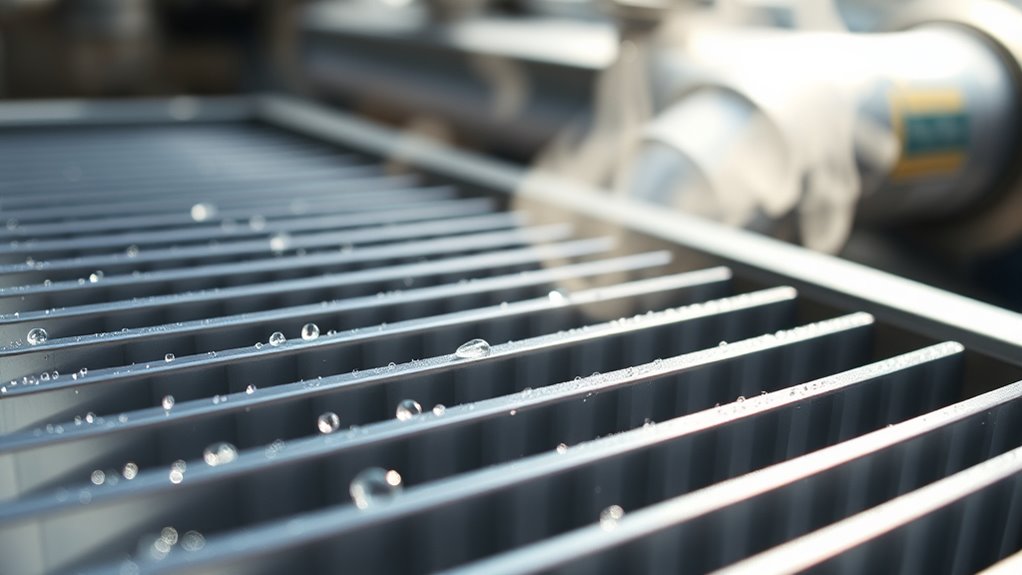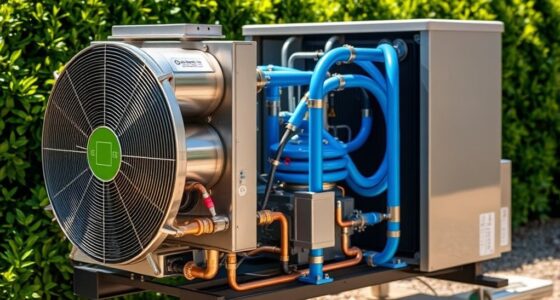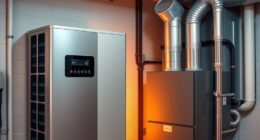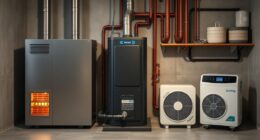Heat sources and sinks play a crucial role in your heat pump’s efficiency by enabling effective heat transfer. Choosing the right source, like ground or water, provides stable energy, while proper sinks, such as well-designed heat exchangers, help dissipate heat effectively. Good heat management reduces energy consumption and prevents system overload. Optimizing these elements ensures your heat pump works at its best—discover how innovations and design strategies enhance this process further.
Key Takeaways
- Effective heat sources provide consistent thermal energy, reducing the workload and increasing heat pump efficiency.
- Proper heat sink design enhances heat dissipation, preventing system overheating and maintaining optimal performance.
- High-conductivity materials in heat exchangers improve heat transfer, boosting overall system efficiency.
- Selecting suitable heat sources (air, ground, water) based on climate stabilizes temperatures and optimizes energy use.
- Advanced heat sink technologies and materials facilitate better heat rejection, improving the heat pump’s operational effectiveness.
Understanding Heat Sources in Heat Pump Systems

Understanding heat sources in heat pump systems is crucial because these sources directly influence the system’s efficiency and performance. Your heat pump relies on heat sources like outdoor air, ground, water bodies, and waste heat flows to gather thermal energy. Natural sources provide sustainable energy inputs that enhance efficiency. For example, outdoor air can be used even at -20 °C, making air-source heat pumps effective in cold climates by extracting heat through heat transfer processes. Ground heat sources offer stable temperatures and are cost-effective, especially at depths of 5-6 meters. Water sources such as lakes or rivers provide consistent, high-quality thermal energy, often at higher temperatures than air or ground. Waste heat from industrial processes or wastewater can also be recovered, further improving your heat pump’s efficiency. Additionally, the integration of regulatory standards helps ensure that heat source utilization is environmentally sustainable and energy-efficient. Properly managing these sources can significantly impact the overall performance and longevity of the system. Moreover, understanding the vibrational energy involved in various sources can help optimize heat extraction and system operation. Employing advanced heat transfer techniques can further maximize efficiency and system responsiveness. Recognizing the thermal conductivity of different heat sources allows for better system design and improved energy capture.
The Function and Importance of Heat Sinks

Heat sinks play a vital role in managing the thermal energy generated by electronic components, guaranteeing they operate safely and efficiently. They transfer heat away from sensitive parts through conduction, then dissipate it via convection and radiation. The effectiveness of a heat sink depends on several factors: Material choice—high thermal conductivity materials like aluminum or copper boost heat dissipation. Surface area—adding fins increases Surface area, improving heat transfer. Design—optimized airflow enhances convection around the electronic components. Placement—proper positioning ensures maximum contact and heat flow away from critical parts. Additionally, understanding the role of automation in designing advanced cooling solutions can further improve heat sink performance. The integration of automated manufacturing processes can lead to more precise and efficient heat sink designs. Using a well-designed heat sink prevents overheating, extends component lifespan, and stabilizes performance, making it an essential element in thermal management systems. Incorporating advanced materials such as graphene or phase change materials can further optimize heat dissipation capabilities. Moreover, ongoing research into thermal interface materials aims to reduce thermal resistance between components and heat sinks. Implementing innovative manufacturing techniques can also enhance the overall quality and consistency of heat sinks.
How Heat Transfer Impacts System Efficiency

Efficient heat transfer is essential for maximizing the overall effectiveness of a heat pump system. When heat transfer occurs smoothly, your system absorbs and releases heat more effectively, boosting efficiency. High thermal conductivity materials like copper or aluminum in heat exchangers reduce temperature gradients, enabling faster heat exchange. Increasing surface area and optimizing fin design in heat sinks or heat exchangers further enhances convective heat transfer, which lowers the temperature differential between the heat source and sink. Maintaining the right temperature differential minimizes compressor work and improves the coefficient of performance (COP). If heat transfer is inadequate, temperature drops on either side can decrease efficiency, causing your system to work harder and consume more energy. Additionally, selecting the right heat transfer materials can significantly influence system performance. Proper maintenance of components such as heat exchangers ensures consistent performance over time. Optimizing these components contributes to better system efficiency and longevity. Moreover, using materials with high thermal conductivity helps facilitate more effective heat transfer. Recognizing the importance of thermal properties in material selection can further enhance heat transfer performance. Consequently, optimizing heat transfer is critical for system performance.
Types of Heat Sources Utilized in Heat Pumps

The effectiveness of a heat pump largely depends on the type of heat source it utilizes. Different sources provide thermal energy essential for efficient heat transfer. Here are four common types:
Choosing the right heat source is key to maximizing your heat pump’s efficiency and energy savings.
- Outdoor air, which remains a viable heat source even at temperatures as low as -20°C, supporting versatile air-source heat pumps. Building heat efficiency can be significantly affected by the quality of this heat transfer process. Properly designed heat exchange systems are crucial to maximize performance in cold climates. Additionally, advancements in air-source heat pump technology have improved performance in colder environments, expanding their applicability.
- Ground heat, offering stable, abundant thermal energy through shallow horizontal systems or vertical boreholes. The use of ground sources often requires careful assessment of local geology and temperature stability.
- Water sources like lakes, rivers, or groundwater, providing consistent temperatures ideal for heat transfer. Utilizing water sources can increase efficiency but may involve environmental considerations.
- Waste heat from industrial processes or exhaust air, which can be recovered and used to boost heat pump efficiency. This approach promotes sustainable energy practices and reduces overall energy consumption.
- The integration of lifestyle considerations, such as location and environmental impact, can influence the optimal choice of heat source for your system.
Design Considerations for Effective Heat Sinks

Designing effective heat sinks requires careful attention to how surface area, material choice, and airflow interact to remove heat efficiently. You should maximize surface area through fin design, adjusting fin density and spacing based on airflow conditions to enhance heat dissipation. Selecting materials with high thermal conductivity, like copper or aluminum, reduces thermal resistance and improves heat transfer. Fin geometries, such as straight, pin, or curved fins, influence airflow patterns and impact thermal performance. Incorporating forced convection with fans or blowers can considerably improve heat removal, especially in high-power applications. Additionally, proper thermal interface materials and mounting pressure ensure ideal contact between the heat source and sink, further minimizing thermal resistance. Moreover, understanding airflow dynamics is crucial for optimizing heat sink performance in various configurations. Utilizing sound healing science principles, such as specific frequencies, can also be explored to optimize system vibrations and heat dissipation in advanced cooling solutions. These considerations help create a heat sink that effectively manages heat and maintains system efficiency.
The Role of Heat Sources in Seasonal Performance

Seasonal performance of heat pumps heavily depends on the availability and stability of heat sources, which can vary widely throughout the year. Your choice of heat source impacts efficiency across seasons. For example:
- Outdoor air remains a useful heat source even at -20 °C, influencing seasonal performance.
- Ground heat offers stable temperatures, providing consistent efficiency during winter, especially with ground storage techniques.
- Water sources like lakes or groundwater have seasonal variation but generally maintain stable temperatures, boosting year-round performance.
- Waste heat from industrial or wastewater sources can drastically enhance efficiency when integrated into the system.
- The presence of delicate skin or sensitivities can affect the suitability of certain heat sources or the design of the heat pump system.
- The efficiency of heat pumps also depends on the temperature differential between the heat source and the heat pump, which varies with seasonal changes, emphasizing the importance of choosing a stable source.
- Proper system design and source selection are crucial for maximizing seasonal performance and ensuring reliable operation throughout the year.
- Moreover, understanding the energy transfer mechanisms involved in different heat sources can help optimize system configuration for better seasonal adaptability.
- Advances in heat pump technology continue to improve their ability to operate efficiently across a wider range of temperatures and sources.
Managing Heat Dissipation for Optimal Operation

Effective heat dissipation is essential for maintaining the efficiency and durability of your heat pump system. Proper thermal management prevents overheating of components like compressors and evaporators, ensuring they operate within safe temperature ranges. Using high-quality heat sinks or heat exchangers made of copper or aluminum enhances heat transfer, reducing heat buildup. This approach aligns with the growing importance of market growth projected at over 40% CAGR in AI tech by 2025, as advanced thermal solutions often incorporate intelligent monitoring systems. Incorporating self regulating cooling mechanisms can further optimize system performance, especially in demanding industrial environments. This minimizes risks such as thermal runaway and system failures, especially in industrial applications. Balancing heat absorption from natural sources with efficient rejection into the sink optimizes overall performance. Consider the following:
| Component | Role in Heat Dissipation | Material of Choice |
|---|---|---|
| Heat sinks | Dissipate heat from critical parts | Copper or Aluminum |
| Heat exchangers | Facilitate heat transfer | Copper or Aluminum |
| Fans/Blowers | Improve airflow for heat removal | Plastic or Metal |
| Thermal pads | Enhance contact for heat transfer | Silicone-based |
| Cooling fins | Increase surface area for dissipation | Aluminum |
Factors Influencing Heat Sink Effectiveness

The ability of a heat sink to transfer heat efficiently depends on several key factors. First, the thermal conductivity of your material matters—copper outperforms aluminum in conducting heat, so choose wisely. Second, increasing surface area through fin design—like fin density and height—boosts convective heat transfer. Third, airflow rate, whether natural or forced with fans, directly impacts how quickly heat is removed. Fourth, proper contact with the heat source is essential; thermal interface materials reduce thermal resistance, ensuring better heat transfer. Additionally, fin spacing must be optimized: too close hampers airflow, while too wide reduces surface contact. By paying attention to these factors, you improve your heat sink’s effectiveness and your heat pump’s overall efficiency.
Integrating Heat Sources and Sinks for Energy Savings

You can boost your heat pump’s efficiency by effectively integrating natural heat sources like ground or water, which provide steady thermal energy. Combining these sources with optimized heat sinks, such as indoor water or air systems, improves heat transfer and reduces energy use. Using seasonal heat storage allows you to store excess heat in summer, further cutting costs during winter.
Optimizing Natural Heat Sources
Integrating natural heat sources and sinks is essential for maximizing heat pump efficiency and reducing energy consumption. To optimize natural heat sources, consider these strategies:
- Use ground heat extraction to tap into stable underground temperatures, improving thermal performance year-round.
- Incorporate water sources like lakes or aquifers, which provide abundant, consistent heat for enhanced seasonal energy use.
- Leverage waste heat recovery from industrial processes or wastewater, decreasing reliance on external sources.
- Design systems that balance heat extraction and rejection, ensuring efficient operation even at low outdoor air temperatures.
This approach boosts heat pump efficiency by harnessing reliable, natural energy flows and minimizing energy waste, leading to more sustainable and cost-effective heating and cooling.
Enhancing Heat Sink Efficiency
Enhancing heat sink efficiency involves optimizing the transfer of heat between natural sources and the heat pump system. You can improve thermal transfer by increasing the surface area of the heat sink, such as adding fins or other structures, to boost convective heat transfer. Selecting high-conductivity heat sink materials like copper or aluminum ensures better heat flow and reduces energy consumption. Incorporating phase change materials (PCMs) allows the heat sink to store and release heat, enhancing seasonal energy savings. Properly matching heat source temperatures with heat sink design parameters maximizes heat source effectiveness, lowering operational costs. By focusing on these factors, you can markedly improve the overall performance of your heat pump system and achieve more energy savings through better integration of natural heat sources and sinks.
Seasonal Heat Storage
Have you considered how seasonal heat storage can considerably boost your heat pump’s efficiency? By storing excess heat from natural heat sources like the ground or water during summer, you create a thermal storage system that works year-round. This process involves:
- Using vertical boreholes or underground reservoirs as heat sinks and sources.
- Leveraging the earth’s stable temperature for efficient heat transfer.
- Reclaiming stored heat in winter to reduce active heating needs.
- Increasing heat pump efficiency by lowering electricity consumption through better thermal storage management.
This integration minimizes reliance on external energy, enhances heat transfer, and maximizes heat pump performance across seasons. Seasonal heat storage not only improves your system’s COP but also leads to lower operational costs and sustainability.
Innovations in Heat Transfer Technologies

Innovations in heat transfer technologies are transforming heat pump efficiency by improving material conductivity and designing smarter heat exchangers. You can leverage advanced materials, like high-conductivity composites, to reduce thermal resistance, while microchannel designs boost heat transfer rates. Additionally, integrating smart controls helps optimize heat flow, maximizing performance across varied operating conditions.
Enhanced Material Conductivity
Recent advances in heat transfer technologies focus on developing materials with superior thermal conductivity, which substantially improve heat sink performance. You can now utilize high-conductivity alloys, nanostructured coatings, and phase change materials to boost heat transfer efficiency. These innovations include:
- Graphene and diamond composites with thermal conductivities over 2000 W/m·K, outperforming traditional materials.
- Interface materials with ultra-thin, conformable layers that minimize gaps and improve heat transfer.
- Phase change materials that absorb and release heat during phase transitions, smoothing thermal loads.
- High-conductivity alloys and composites designed to dissipate heat rapidly, supporting higher thermal loads.
These advancements enable better heat sink materials, reduce thermal resistance, and enhance overall heat pump efficiency.
[ALTERNATIVE WORD FOR ‘TRANSITION’]: progressionAdvanced Heat Exchanger Designs
Advanced heat exchanger designs are transforming heat pump systems by maximizing surface area and improving heat transfer efficiency. Microchannel and plate heat exchangers offer increased surface contact, boosting thermal conductivity and enabling faster heat dissipation. Material advancements, such as high thermal conductivity composites and coated surfaces, reduce thermal resistance, optimizing heat exchange. Technologies like heat pipes and vapor chambers facilitate passive heat transfer over longer distances with minimal temperature gradients, enhancing system performance. Fin structures and finless designs, including printed circuit heat exchangers, create compact, lightweight configurations that improve airflow and heat dissipation. Additive manufacturing allows for complex geometries, further increasing surface contact and thermal performance. These innovations collectively push heat transfer efficiency to new levels, making heat pumps more effective and energy-efficient.
Smart Control of Heat Flow
Building on improvements in heat transfer surfaces and materials, smart control systems now play a vital role in optimizing heat flow within heat pump systems. They use real-time data and adaptive algorithms to regulate heat transfer, enhancing efficiency. With advanced sensors and IoT integration, you can monitor temperature differentials and source conditions precisely. These technologies enable dynamic adjustments that maximize thermal conductivity and minimize energy waste. Consider these innovations:
- Sensors detecting temperature changes for immediate response.
- IoT-enabled controls adjusting heat flow based on real-time data.
- Thermoelectric modules providing reversible, localized heat transfer.
- Microchannel heat exchangers enhancing surface area and heat transfer coefficients.
Together, these smart control strategies create a responsive system that optimizes heat transfer, improves efficiency, and reduces operational costs.
Frequently Asked Questions
What Is the Purpose of a Heat Sink?
You ask about the purpose of a heat sink, and it’s simple: it helps keep electronic components cool by transferring heat away from them. By increasing surface area with fins and using conduction, convection, and radiation, it efficiently disperses heat into the environment. This prevents overheating, prolongs component life, and ensures your devices run smoothly and reliably at higher performance levels.
What Makes a Heat Pump Efficient?
Imagine feeling comfortable even on the coldest days—that’s what makes a heat pump efficient. You see, when the temperature difference between the heat source and sink is small, your system works better. Using natural, stable heat sources like ground or waste heat helps keep things running smoothly. Choosing the right components and design allows your heat pump to transfer heat effectively, saving energy and boosting performance.
What Is a Heat Sink in a Heat Pump?
A heat sink in a heat pump is the component or environment that absorbs and releases heat during operation. You’ll find it outside, like the air, ground, or water, where heat is expelled after being absorbed from the source. Its design is essential; efficient heat sinks increase surface area and airflow, helping your system stay cool and operate smoothly, boosting overall efficiency.
What Is Heat Sink Vs Source?
Think of a heat source as the sun’s warmth reaching you and a heat sink as the cool shade you seek. In a heat pump, your heat source is where heat is pulled from—like outdoor air or ground—while the heat sink is where the heat gets delivered—inside your home. Understanding this balance helps optimize your system’s efficiency, especially when temperatures vary greatly between source and sink.
Conclusion
Understanding heat sources and sinks is like mastering a dance—they work together to keep your heat pump running smoothly. When you optimize heat transfer, it’s as if you’ve tuned an instrument to perfection, boosting efficiency and saving energy. By managing heat dissipation effectively, you guarantee your system performs at its best, much like a well-oiled machine. Embrace these innovations, and you’ll enjoy a more efficient, reliable heat pump that keeps your home comfortable with less effort.









